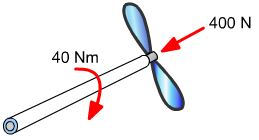Re-use of this resource is governed by a Creative Commons
Attribution-
NonCommercial-ShareAlike 4.0 International
https://creativecommons.org/licenses/by-nc-sa/4.0/
NonCommercial-ShareAlike 4.0 International
https://creativecommons.org/licenses/by-nc-sa/4.0/
Yield Criteria for Metals
It is proposed to fabricate the propeller drive shaft
for a human-powered aircraft from a thin-walled tube of an aluminium
alloy, with a uniaxial yield stress of 400 MPa. The shaft is to be 20
mm in diameter. In service, the shaft will be subjected to a driving
torque of 40 Nm and a simultaneous, axial compressive thrust from the
propeller of 400 N.
Using the Tresca yield criterion, show that the minimum thickness is 0.319 mm.

Using the Tresca yield criterion, show that the minimum thickness is 0.319 mm.

Hint:
Compressive stress is given by
\[\sigma = \frac{W}{2\pi rt}\] where W is compressive thrust
t is thickness
r is radius
For a thin-walled tube, a driving torque produces a shear stress given by
\[ \tau = \frac{Q}{2\pi r^{2}t}\] where W is driving torque.
Compressive stress is given by
\[\sigma = \frac{W}{2\pi rt}\] where W is compressive thrust
t is thickness
r is radius
For a thin-walled tube, a driving torque produces a shear stress given by
\[ \tau = \frac{Q}{2\pi r^{2}t}\] where W is driving torque.
W = 400 N, Q = 40 Nm, r =
10 mm.
Since \(\sigma = \frac{W}{2\pi rt}\) and \(\tau = \frac{Q}{2\pi r^{2}t}\), therefore σ = -0.1τ or τ = −10σ.
We can use Mohr's circle to calculate the principal stresses in the wall of the tube:
Since \(\sigma = \frac{W}{2\pi rt}\) and \(\tau = \frac{Q}{2\pi r^{2}t}\), therefore σ = -0.1τ or τ = −10σ.
We can use Mohr's circle to calculate the principal stresses in the wall of the tube:
\(\left( {\begin{array}{*{20}{c}} - \sigma &
\tau\\ \tau & 0\\ \end{array}} \right)\) is the 2D stress tensor.
The principal stresses are:
\[\sigma_{p}=-\frac{\sigma }{2}\pm \sqrt(100.25))\left | \sigma \right | \] From the circle, it is clear that the shear stress is dominant, as:
τ = −10σ
The principal stresses are:
\[\sigma_{p}=-\frac{\sigma }{2}\pm \sqrt(100.25))\left | \sigma \right | \] From the circle, it is clear that the shear stress is dominant, as:
τ = −10σ
The third principal stress acts radials on the thin-walled
tube and is zero. Therefore, the largest difference in principal stresses
is equal to:
\[ 2 \sqrt(100.25))\left | \sigma \right |=2k=\gamma \] where k is the shear yield stress and γ is the uniaxial shear stress.
We are given γ = 400 MPa. Hence, σ = -19.975 MPa at yield.
Thus, the minimum thickness of the tube wall is:
\[t = \frac{W}{2\pi r\left | \sigma \right |} = \frac{400}{2\pi \times 10^{-2}\times19.975 \times 10^{5}}\mathrm{m} = 0.319\mathrm{mm}\] However, we need to assume a reasonable factor for safety, e.g. 3, so t ~1 mm would be a reasonable thickness of the tube wall.
\[ 2 \sqrt(100.25))\left | \sigma \right |=2k=\gamma \] where k is the shear yield stress and γ is the uniaxial shear stress.
We are given γ = 400 MPa. Hence, σ = -19.975 MPa at yield.
Thus, the minimum thickness of the tube wall is:
\[t = \frac{W}{2\pi r\left | \sigma \right |} = \frac{400}{2\pi \times 10^{-2}\times19.975 \times 10^{5}}\mathrm{m} = 0.319\mathrm{mm}\] However, we need to assume a reasonable factor for safety, e.g. 3, so t ~1 mm would be a reasonable thickness of the tube wall.